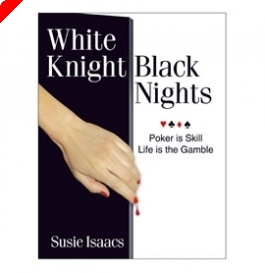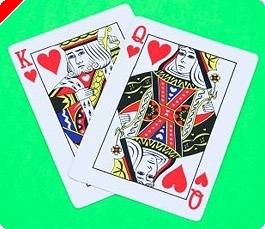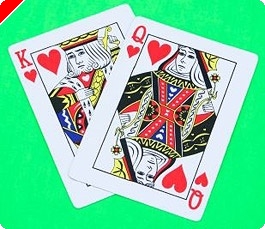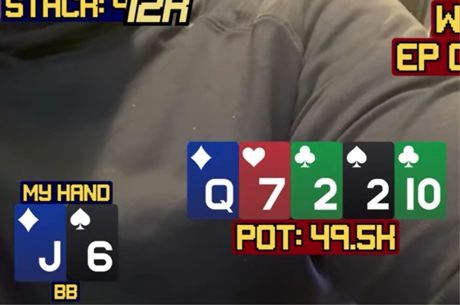He Said, She Said, Vol. 5: Ivey vs. Jackson
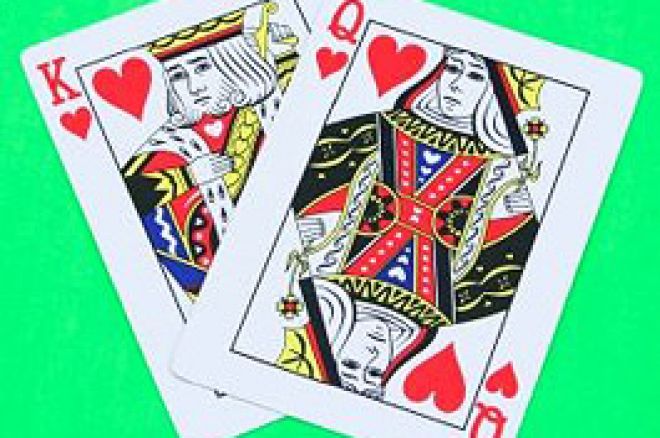
Locale: Heads-up in Monte Carlo for a million dollars, featuring Phil Ivey vs. Paul Jackson.
The Blinds: 12,000/24,000 with a 4,000 ante.
Chip counts: Jackson, roughly one million; Ivey, roughly four million.
The Hand:
Jackson: 6♠5♦
Ivey: Q♥8♥
Preflop: Jackson completes the small blind for 12,000, Ivey raises to 74,000, and Jackson calls.
Tony: Jackson limps and Ivey raises about three times the pot. Jackson calls. At this point, listing Jackson's entire range would be gratuitous but we can eliminate a few relevant hands, 7-7, A-J, and K-J. These hands would almost never simply limp-call the button in a heads-up match.
Celina: Preflop, Jackson makes a standard call in the small blind with 6-5, and Ivey makes a raise with Q-8 suited, out of position in the big blind. Ivey can either raise or check in this situation, depending on how he feels about playing this hand out of position and disguising what his raising-hand ranges could be.
Flop: 7♣J♣J♥ (Pot: 176,000) Ivey leads out for 80,000, Jackson raises to 170,000, Ivey reraises to 320,000, Jackson reraises to 470,000, and Ivey declares all in (for Jackson's remaining 380,000). Jackson folds.
Tony: The first time I saw this hand my head nearly exploded. It seemed completely inconceivable to me, almost impossible. Looking at it a year later, it makes a lot more sense. To understand this hand you to examine each action and interpret what Phil Ivey perceives Paul Jackson's possible range to be.
On the flop, Ivey leads 80,000. This is, of course, pretty standard. Jackson now raises to 170,000. At this point, Ivey imagines Jackson's range to be something like flush draws, J-x, 7-x, bluffs, 9-8, 10-9. Ivey thinks it over, and decides it's unlikely Jackson would raise a jack at this point based on history, and three-bets Jackson to 320,000. Jackson briefly considers, then min-reraises to 470,000, leaving only about 380,000 behind. This is where Jackson really screwed up and where he let Ivey put the pieces together. Ivey knows if Jackson is on a semi-bluff with a flush draw or gutshot straight draw that he will go all in, instead of min-four-betting, which leaves an awkward amount of chips behind.
Ivey also knows that with J-x, Jackson is almost always just calling Ivey's three-bet since Ivey is out of position and may continue to bluff the turn by making a bet that commits him for Jackson's stack while way behind. He also knows that if Jackson has a jack he wouldn't four-bet this size since it makes the strength of his hand too obvious against a thinking player. Ivey can also eliminate a seven from Jackson's range since he's taking a hand with a whole lot of showdown value and turning it into a bluff, and Ivey knows Jackson plays too well to do something like that. Therefore, Ivey deduces that the only hand left in Jackson's range is a bluff. Ivey moves in (and despite the logic, it's still one of the sickest plays I've ever seen) after putting the pieces together, and Jackson folds.
Celina: Ivey's lead here is a very standard play, since most advanced poker players lead a paired board a lot of the time. Jackson plays back and reraises Ivey, knowing that he is capable of betting a flop of this texture to represent a strong hand. The flop allows the possibility of a flush draw or any pairs ranging from 2-2 to A-A to be played aggressively. Jackson's reraise here doesn't make much sense to Ivey due to his limp and call preflop. Ivey would have to put him on A-x, a small club draw or a small pocket pair lower than sevens. The possibility of Jackson having a seven or jack is eliminated in Ivey's mind due to the aggression that Jackson is displaying on the flop, since a hand like that will just call Ivey and allow him to bet again on the turn and the river.
Ivey thus reraises, knowing that Jackson probably has a hand that most likely will fold to a reraise. Jackson briefly considered Ivey's three-bet, already prepared for this anticipated move from the aggressive Ivey, and makes the four-bet. Now it goes back to Ivey, where he can now put Jackson on a hand that is a pure bluff, can't beat a pair of sevens, or is a small flush draw. Ivey goes all in after considering all his options, thinking that if he goes all in here, he has two overcards with a backdoor flush draw, against what is at worst (for Ivey) Jackson's small pocket pair or a small flush draw. The all-in bet also has the advantage of still having fold equity against hands such as A-x and small pocket pairs. Both players made probing bets on the flop, where the raising amount was minimal, rather than the standard 2.5x-to-3x raise. This allowed five bets to occur, including Ivey's all-in move. The hand was crazy to watch and hard to comprehend, but both players' minds and metagames really made this a hand to remember.
Tony 'Bond18' Dunst is a professional online poker player living in Australia. Dunst is one of the moderators of the strategy forum at 2+2, and is noted for his tongue-in-cheek recaps of big stories in the online poker world that he posts there and at pocketfives. Celina Lin is Tony's girlfriend and a good player in her own right. In fact, Celina has just signed on with PokerStars as a player/endorser, and will represent Team PokerStars at events all over the world. These two spend an incredible amount of time at home discussing poker hands. In each volume of this ongoing column, Dunst and Lin break down a hand and 'discuss' it in a way only a boyfriend and girlfriend can.

